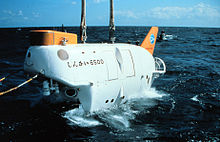Japan Agency for Marine Earth Science and Technology
The Japan Agency for Marine Earth Science and Technology ( JAMSTEC; Japanese 海洋 研究 開 発 機構 , kaiyō kenkyū kaihatsu kikō , German "oceanic research and development organization") is a self-governing body ( dokuritsu gyōsei hōjin ) for geology and oceanology Based in Yokosuka . It emerged in 2004 from its predecessor, the Japan Marine Science and Technology Center . The main task of the institute is to promote scientific research in the field of oceanology and marine technology . Special care is given to achieving progress in basic research and improving and expanding marine development potential. This support is linked to the spirit of securing world peace and human well-being.
These subsidies are embedded in monitoring strategies that operate worldwide , such as those of Japan ARGO , a UNESCO project of the World Meteorological Organization (WMO) . Real-time analyzes of the research objects are carried out using high-resolution techniques. Other projects include a. Climate Variability & Predictability (CLIVAR) or the Global Earth Observing System of Systems (GEOSS) of the Group on Earth Observation (GEO) . They research climate change ( global warming ) and the predictability of natural and marine disasters in international cooperation, also with the help of earth observation satellites such as the Argentine SAC-D .
The Office entertained deep - database systems , benthic cameras and deep collections of images.
See also
- Intergovernmental Oceanographic Commission (of UNESCO)
- Consortium for Ocean Leadership ( non-governmental organization )
Web links
- Official website (Japanese, English)
- Intergovernmental Oceanographic Commission (IOC)
- International Oceanographic Data and Information Exchange (IODE)
Individual evidence
- ↑ About JAMSTEC (English)
- ↑ CLIVAR Overview
- ↑ GEOSS on-line
- ↑ Deep Sea Image Database ( Memento from February 20, 2009 in the Internet Archive )


